N1 Rocket - Mac Rebisz

N1 Rocket - Mac Rebisz
More Posts from Epic-flight and Others

Cesare Reggiani

USS Sulaco Military Starship
Movie: Aliens UI Design: Fantasy II Film Effects, L.A. Effects Group, Stan Winston Studio


signal space

The Sun photographed in a “specific red color of light emitted by hydrogen gas called Hydrogen-alpha and then color inverted to appear blue.” Courtesy of Alan Friedman (Averted Imagination). (NASA)

‘antipode’

Dunes on the floor of the Endurance Crater on Mars, November 16, 2004.
(Planetary Society)

Richard Bizley

Seven Sisters surrounded by cosmic dust © astrofalls
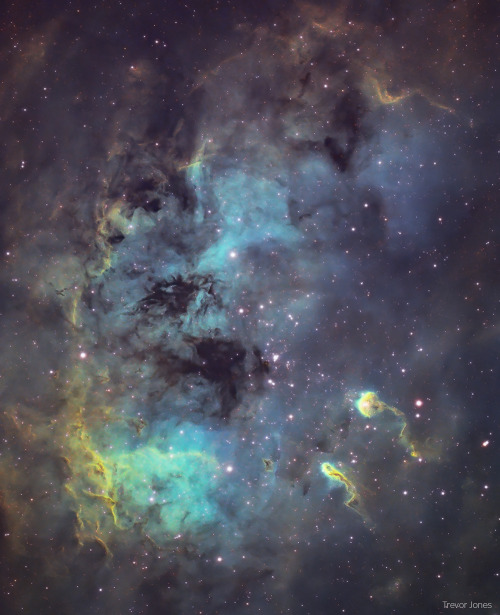
The Tadpoles of IC 410 : This telescopic close-up shows off the central regions of otherwise faint emission nebula IC 410, captured under backyard suburban skies with narrowband filters. It also features two remarkable inhabitants of the cosmic pond of gas and dust. Below and right of center are the tadpoles of IC 410. Partly obscured by foreground dust, the nebula itself surrounds NGC 1893, a young galactic cluster of stars. Formed in the interstellar cloud a mere 4 million years ago, the intensely hot, bright cluster stars energize the glowing gas. Composed of denser cooler gas and dust, the tadpoles are around 10 light-years long and are likely sites of ongoing star formation. Sculpted by stellar winds and radiation their heads are outlined by bright ridges of ionized gas while their tails trail away from the cluster’s central young stars. IC 410 lies some 10,000 light-years away, toward the nebula-rich constellation Auriga. via NASA
You Are Made of Stardust
Though the billions of people on Earth may come from different areas, we share a common heritage: we are all made of stardust! From the carbon in our DNA to the calcium in our bones, nearly all of the elements in our bodies were forged in the fiery hearts and death throes of stars.
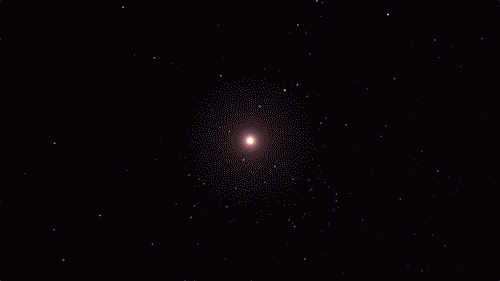
The building blocks for humans, and even our planet, wouldn’t exist if it weren’t for stars. If we could rewind the universe back almost to the very beginning, we would just see a sea of hydrogen, helium, and a tiny bit of lithium.
The first generation of stars formed from this material. There’s so much heat and pressure in a star’s core that they can fuse atoms together, forming new elements. Our DNA is made up of carbon, hydrogen, oxygen, nitrogen, and phosphorus. All those elements (except hydrogen, which has existed since shortly after the big bang) are made by stars and released into the cosmos when the stars die.

Each star comes with a limited fuel supply. When a medium-mass star runs out of fuel, it will swell up and shrug off its outer layers. Only a small, hot core called a white dwarf is left behind. The star’s cast-off debris includes elements like carbon and nitrogen. It expands out into the cosmos, possibly destined to be recycled into later generations of stars and planets. New life may be born from the ashes of stars.
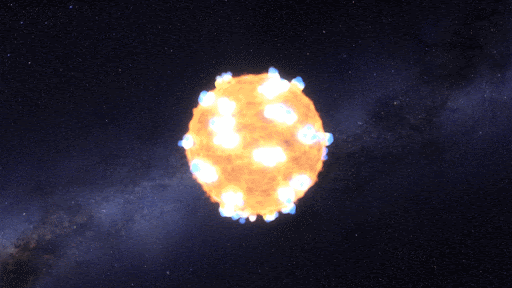
Massive stars are doomed to a more violent fate. For most of their lives, stars are balanced between the outward pressure created by nuclear fusion and the inward pull of gravity. When a massive star runs out of fuel and its nuclear processes die down, it completely throws the star out of balance. The result? An explosion!
Supernova explosions create such intense conditions that even more elements can form. The oxygen we breathe and essential minerals like magnesium and potassium are flung into space by these supernovas.
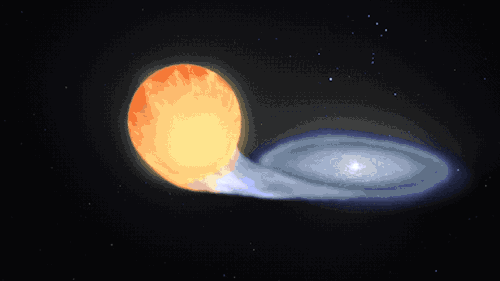
Supernovas can also occur another way in binary, or double-star, systems. When a white dwarf steals material from its companion, it can throw everything off balance too and lead to another kind of cataclysmic supernova. Our Nancy Grace Roman Space Telescope will study these stellar explosions to figure out what’s speeding up the universe’s expansion.
This kind of explosion creates calcium – the mineral we need most in our bodies – and trace minerals that we only need a little of, like zinc and manganese. It also produces iron, which is found in our blood and also makes up the bulk of our planet’s mass!

A supernova will either leave behind a black hole or a neutron star – the superdense core of an exploded star. When two neutron stars collide, it showers the cosmos in elements like silver, gold, iodine, uranium, and plutonium.

Some elements only come from stars indirectly. Cosmic rays are nuclei (the central parts of atoms) that have been boosted to high speed by the most energetic events in the universe. When they collide with atoms, the impact can break them apart, forming simpler elements. That’s how we get boron and beryllium – from breaking star-made atoms into smaller ones.
Half a dozen other elements are created by radioactive decay. Some elements are radioactive, which means their nuclei are unstable. They naturally break down to form simpler elements by emitting radiation and particles. That’s how we get elements like radium. The rest are made by humans in labs by slamming atoms of lighter elements together at super high speeds to form heavier ones. We can fuse together elements made by stars to create exotic, short-lived elements like seaborgium and einsteinium.
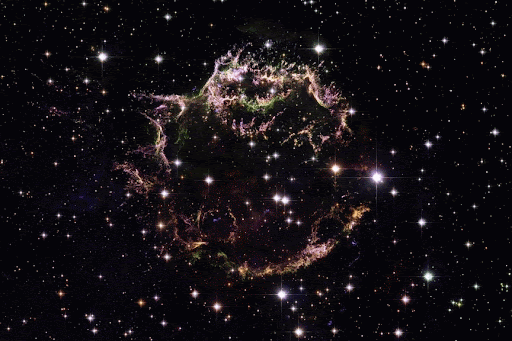
From some of the most cataclysmic events in the cosmos comes all of the beauty we see here on Earth. Life, and even our planet, wouldn’t have formed without them! But we still have lots of questions about these stellar factories.
In 2006, our Stardust spacecraft returned to Earth containing tiny particles of interstellar dust that originated in distant stars, light-years away – the first star dust to ever be collected from space and returned for study. You can help us identify and study the composition of these tiny, elusive particles through our Stardust@Home Citizen Science project.
Our upcoming Roman Space Telescope will help us learn more about how elements were created and distributed throughout galaxies, all while exploring many other cosmic questions. Learn more about the exciting science this mission will investigate on Twitter and Facebook.
Make sure to follow us on Tumblr for your regular dose of space!
-
 julesrj liked this · 3 years ago
julesrj liked this · 3 years ago -
 dbretz76db reblogged this · 3 years ago
dbretz76db reblogged this · 3 years ago -
 cormallen reblogged this · 3 years ago
cormallen reblogged this · 3 years ago -
 deathsu-34fullback reblogged this · 3 years ago
deathsu-34fullback reblogged this · 3 years ago -
 contemporaryuser liked this · 3 years ago
contemporaryuser liked this · 3 years ago -
 bisexual-kaidan-alenko liked this · 4 years ago
bisexual-kaidan-alenko liked this · 4 years ago -
 takeshi-k0vacs reblogged this · 4 years ago
takeshi-k0vacs reblogged this · 4 years ago -
 takeshi-k0vacs liked this · 4 years ago
takeshi-k0vacs liked this · 4 years ago -
 epic-flight reblogged this · 4 years ago
epic-flight reblogged this · 4 years ago -
 enkanys liked this · 5 years ago
enkanys liked this · 5 years ago -
 idazaejrob reblogged this · 5 years ago
idazaejrob reblogged this · 5 years ago -
 anxvu reblogged this · 6 years ago
anxvu reblogged this · 6 years ago -
 anxvu liked this · 6 years ago
anxvu liked this · 6 years ago -
 alexandrugionea liked this · 6 years ago
alexandrugionea liked this · 6 years ago -
 chernyy-voskhod liked this · 6 years ago
chernyy-voskhod liked this · 6 years ago -
 eswat2 liked this · 6 years ago
eswat2 liked this · 6 years ago -
 london-architect22 liked this · 6 years ago
london-architect22 liked this · 6 years ago -
 ineedmorestormlighter reblogged this · 6 years ago
ineedmorestormlighter reblogged this · 6 years ago -
 friendlyoceanmower liked this · 6 years ago
friendlyoceanmower liked this · 6 years ago -
 apexgrodd liked this · 6 years ago
apexgrodd liked this · 6 years ago -
 joz66 liked this · 6 years ago
joz66 liked this · 6 years ago -
 lazilycoraldaze-blog liked this · 6 years ago
lazilycoraldaze-blog liked this · 6 years ago -
 mnjr23rd liked this · 6 years ago
mnjr23rd liked this · 6 years ago -
 jeramiahcorncob reblogged this · 6 years ago
jeramiahcorncob reblogged this · 6 years ago -
 jeramiahcorncob liked this · 6 years ago
jeramiahcorncob liked this · 6 years ago -
 captain-hiz96 reblogged this · 6 years ago
captain-hiz96 reblogged this · 6 years ago -
 hztxtshx liked this · 6 years ago
hztxtshx liked this · 6 years ago -
 millerscritters reblogged this · 6 years ago
millerscritters reblogged this · 6 years ago -
 captain-hiz96 liked this · 6 years ago
captain-hiz96 liked this · 6 years ago -
 captainignis reblogged this · 6 years ago
captainignis reblogged this · 6 years ago -
 captainignis liked this · 6 years ago
captainignis liked this · 6 years ago -
 nodaudaboutitt reblogged this · 6 years ago
nodaudaboutitt reblogged this · 6 years ago -
 reddog1984 reblogged this · 6 years ago
reddog1984 reblogged this · 6 years ago -
 i-j0s liked this · 6 years ago
i-j0s liked this · 6 years ago
